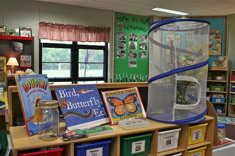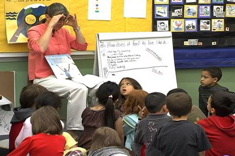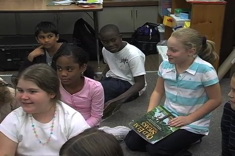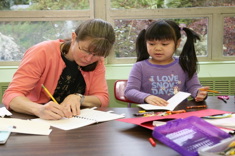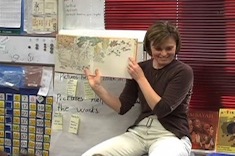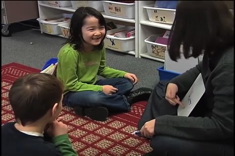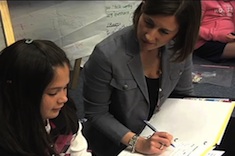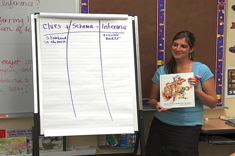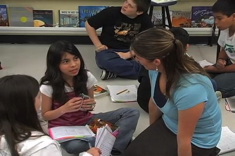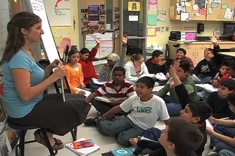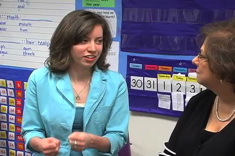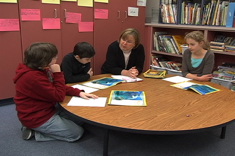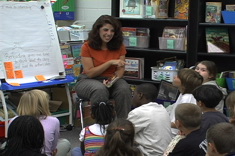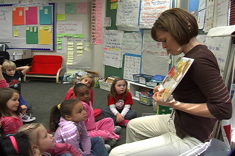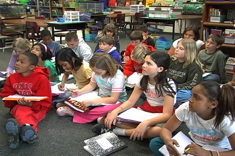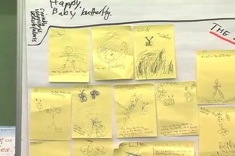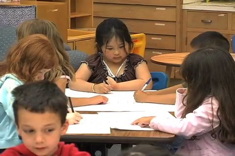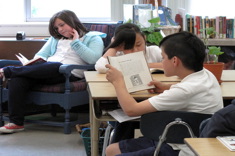Reading Strategies
Are your students buried in post-its? Oversharing with those text-to-self connections? Parroting back comprehension tips but rarely applying them when they are actually reading? Our contributors sort through what works with strategy instruction, and have wise advice for avoiding superficial approaches to developing comprehension skills.
Latest Content
Ready-to-Go Readers’ Theater Books
If you want to do more with readers’ theater to promote fluency, but can’t afford one of those expensive kits, you’ll enjoy this booklist. Shari Frost has compiled her favorite readers’ theater books with texts and illustrations students love.
Towards Thoughtful Strategy Instruction
Sometimes the pendulum swings so hard in education that it’s hard not to feel whiplash. Shari Frost considers critiques of strategy instruction, analyzing what’s valid and what’s not in attacks on the flurry of post-its in classrooms.
Books for Strategy Studies
Andie Cunningham has some thoughtful recommendations for books to use in strategy studies.
Just Because It’s Skinny, Doesn’t Mean It’s Easy: Matching Books to Transitional Readers in Grades 2-4
Franki Sibberson writes about her evolution in choosing books for transitional readers in grades 2-4. Franki includes a handy list of criteria for evaluating whether new short chapter books are appropriate for young readers.
Using Poetry to Promote Reading Fluency
Aimee Buckner shares how to use a mentor text to build fluency through poetry.
Build Fluency with Books That Are Fun for Kids to Read Aloud Over and Over and Over Again
Here’s a booklist of delightful titles that will build fluency skills for students — both as read alouds, and during independent reading.
Wide Open Spaces: Learning from “Not-Just-Right” Books
When is it okay for a child to read a "not-just-right" book, especially one with themes that might be a bit sophisticated or of questionable taste? Andrea Smith confronts this issue as a parent, and thinks through what it might mean for her teaching.
Selecting Texts for Strategy Teaching with English Language Learners in Mind
Text selection for English language learners poses special challenges. Clare Landrigan and Tammy Mulligan explain how the criteria for “just-right books” are different for ELLs, and provide practical examples of how teachers use these principles of book selection in their classrooms.
Envisioning Writing: Wow Words and Mental Images in 1st Grade
In this minilesson, Katie DiCesare uses the book My Cat Copies Me to help her first-grade students “envision” their writing drafts. The lesson focuses on creating mental images to conjure stronger verbs and adjectives while writing.
First Grade Small Group: Chunking
In this small group from Courtney Tomfohr's first-grade classroom, students work on their "chunking" skills.
Conferring About Character Traits
In this conference from a fifth-grade classroom, Clare Landrigan meets with a student to reinforce learning from a whole-class lesson on inferring and character traits.
Small Group After Demonstration Lesson
In this small group after a demonstration lesson in a 5th grade classroom, Clare Landrigan talks through strategies for inferring the meaning of new words while reading.
Inferring Read Aloud Part I
Katie Doherty demonstrates how she uses picture books to teach inferring strategies to her sixth graders in this video series. Part I is a presentation of the book to students.
Teaching Inferring with Picture Books Part II: Partner Shares
Katie Doherty’s 6th grade students discuss the read-aloud through partner shares.
Teaching Inferring with Picture Books Part III: Whole-Class Debrief
Katie Doherty's 6th grade students debrief after a read-aloud and partner share focused on inferring.
Talking About Synthesis: Metaphors from 2nd Graders
In this remarkable discussion, Lauren Scott's second-grade students chat with their teacher and Principal Karen Szymusiak about metaphors for synthesis.
5th Grade Strategy Group on Summarizing
In this strategy group, Karen Terlecky brings together three of her 5th graders to reread a nonfiction article shared with the whole class. They discuss main ideas, and do a writing activity together to build summarizing skills.
Teaching Rereading During Class Read Alouds
Aimee Buckner teaches her fourth graders the power of rereading using the mentor text Goblins in the Castle by Bruce Coville.
Teaching Rereading Strategies Through Read Aloud Day 2
Aimee Buckner uses rereading as a strategy to deepen student understanding during read alouds.
Picture Reading in First Grade
In this read-aloud lesson from Katie DiCesare's first-grade classroom, Katie demonstrates the importance of picture reading using the wordless picture book The Zoo by Suzy Lee.
Test-Taking Skills: Reading Strategies for Word Problems Part I
Question It – Know It – Show It are the keys to test preparation in Andrea Smith's 4th grade classroom.
Creating Anchor Charts with Sticky Note Responses from Young Readers
Over-sized sticky notes are a great learning tool for kindergartners. In this video, Andie Cunningham demonstrates how she uses them with her students.
Moving Beyond the Basics: Teaching Inferring to a Fluent Young Reader
In this conference, Gail Boushey (of “The Sisters”) confers with Brandon and helps him understand the concept of inferring.
Learning to Cross-Check: Conferring with Hailey
Joan Moser confers with five-year-old Hailey and helps her set a reading goal.
Webbing to Learn: A Writing Strategy to Chart Thinking with Young Learners
Andie Cunningham and Ruth Shagoury explain how webs can be a powerful organizing tool for kindergarten writers.
Flexible Groups: Moving Beyond Levels to Assess Reading Needs
Gail Boushey and Joan Moser (“The Sisters”) discuss how their thinking has evolved when it comes to flexible groups. The article includes a video excerpt of Joan working with a group of kindergartners.
What Are the Seven Reading Comprehension Strategies?
Terms like thinking or comprehension strategies get thrown around a lot, but what do we really mean? Brenda Power helps define seven strategies to build common language and understanding.
Small Group Instruction: Inferring Focus
In this example of reading instruction with a small group, Gail Boushey of “The Sisters” leads a discussion of inference, using Peter Rabbit as a focus text. All of the children in the group are reading at different levels independently, but they share a goal of learning more about inferring.
Introducing Bull’s-Eye and Waves Written Responses in Synthesis Work
Andie Cunningham explains the bull’s-eye and wave responses her kindergartners complete to demonstrate their understanding of synthesis. A video introducing the activity is included.
Digging Deep: The Power of Rereading
Max Brand considers how rereading helps students understand and enjoy texts.
Browse Content By
Type
Category
- Assessment Tools
- Big Fresh Archives
- Booklists
- Choice Numeracy
- Classroom Design
- Common Core
- Community Building
- Conferring
- Content Literacy
- Digital Literacy
- English Language Learners
- Equity
- Family Relations
- Free Samples
- Guiding Groups
- Leadership
- Literacy Coaches
- Mentor Texts
- Minilessons
- New Teacher Mentors
- Podcasts
- Poetry
- Quote Collections
- Reading Strategies
- Self Care
- Struggling and Striving Learners
- Talking and Listening
- Teacher Study Groups
- Teaching Reading
- Teaching Writing
- Word Study and Vocabulary
Author
- Melissa Quimby
- Nawal Qarooni
- Gwen Blumberg
- Julie Cox
- The Lead Learners
- Hannah Tills
- Josie Stewart
- Ruth Metcalfe
- Mallory Messenger
- Becca Burk
- Jodie Bailey
- Vivian Chen
- Mary Brower
- Tiffany Abbott Fuller
- Stephanie Affinito
- Ruth Ayres
- Leigh Anne Eck
- Heather Fisher
- Shari Frost
- Julie Johnson
- Suzy Kaback
- Gigi McAllister
- Shirl McPhillips
- Melanie Meehan
- Cathy Mere
- Debbie Miller
- Tara Barnett and Kate Mills
- Tammy Mulligan
- Dana Murphy
- Bitsy Parks
- David Pittman
- Brenda Power
- Heather Rader
- Matt Renwick
- Mandy Robek
- Christy Rush-Levine
- Gretchen Schroeder
- Jen Schwanke
- Brian Sepe
- Katherine Sokolowski
- Stella Villalba
- Jennifer Vincent
Grade Level
Choice Literacy Membership
Articles
Get full access to all Choice Literacy article content
Videos
Get full access to all Choice Literacy video content
Courses
Access Choice Literacy course curriculum and training

